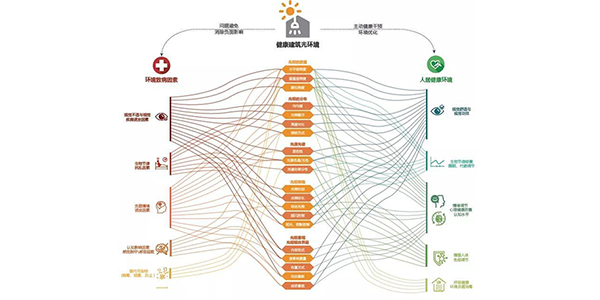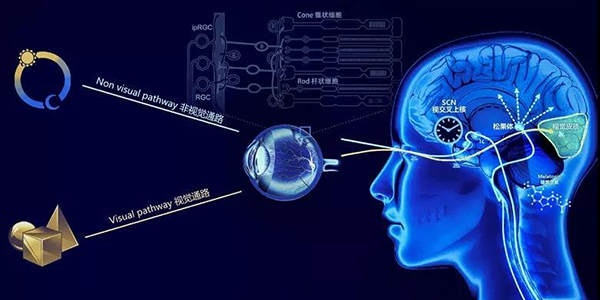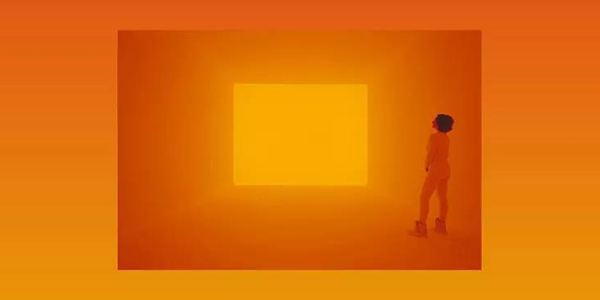Light has a wide range of effects on human visual health, biological rhythms, emotional cognition, metabolism and immunity through visual and non-visual biological effects, and is a key technology for human habitat health with a common focus in the frontier fields of architecture, optics, life science and environmental engineering.
The Healing Role of Light in Habitat Space
Rapid urbanization has led to socio-economic development and improvement of people’s living standards, but also brought serious challenges to human health. The deep aging of the population structure, the accelerating pace of social life, the increasing pressure of competition in work and study, and the frequent use of electronic smart devices have led to a series of visual health problems and also increased the risk of various physical and mental diseases. From the source of health promotion, various health intervention techniques, means and methods to actively regulate the imbalance state need to be urgently explored and developed. Light is the main component of the physical environment of human living space and has a multi-dimensional health effect of “visual-physical-psychological”. The WELL standard, which is widely recognized in the field of healthy buildings, and the nine basic elements of healthy buildings proposed by the Center for Climate, Health and the Global Environment of Harvard School of Public Health, both focus on light environment. It is certain that through the reasonable setting of light quantity, spatial light distribution, light source spectrum and light strategy, as well as the customized design of light landscape and light art media interface, it is of considerable research significance to use light as a direct and effective, safe and side-effect-free means of active health intervention in human living environment to eliminate the negative effects caused by environmental pathogenic factors.
factors affecting the habitat environment
Light environment and visual health
The impact of light on human health is divided into two aspects: visual and non-visual. More than 80% of the information that humans obtain about the external world is obtained through visual means. Therefore, visual quality affects the vast majority of behaviors and activities such as work, entertainment, interaction, and leisure, and is closely related to the quality of life. The eye is the most sophisticated human organ, and poor lighting conditions such as insufficient light, shadows, glare, strobe light, and excessive visual information stimulation will not only lead to reduced visual function, visual fatigue, and reduced operational performance, but also hinder the smooth performance of activities, and their long-term cumulative effects will cause myopia, accelerate macular degeneration, and bring irreversible visual damage. China invests a lot of human and economic resources in national visual health protection every year, and improving the light environment of human living space is one of the key tasks.
There is a complementary relationship between the visual function of the human eye, visual work and the light environment. A large number of studies have been conducted around matching the visual ability of various populations such as adolescents, adults, and the elderly with different operating conditions such as paper, VDT, and fine processing, to achieve the light environment parameters required for optimal visual performance and visual comfort. Under the unremitting efforts of academic organizations and researchers represented by CIE and American scholar Perter Boyce, a consensus has been formed on the impact of individual light environment elements such as illuminance, luminance, visual field brightness distribution, light source color and color rendering on visual quality, and various industry standards and specifications have been introduced at home and abroad to guide the design practice of architectural light environment.
Light and biological rhythms
The human body has a special clock called “biorhythm”, which regulates most of the physiological processes such as sleep, feeding, metabolism, hormone secretion and immune response, maintaining the healthy homeostasis of the body. Disorders of biological rhythm cause obesity, cancer, neurodegenerative diseases and other diseases, and also affect the treatment and rehabilitation of diseases. In addition to cone cells and rod cells, a third type of photoreceptor cells, retinal specialized photoreceptor ganglion cells (ipRGCs), exist in the mammalian retina and are photosensitive to light stimuli and project light signals to the rhythm control center –They are able to directly perceive light stimuli and project light signals to the suprachiasmatic nucleus (SCN), which forms the non-image visual pathway of light and influences the secretion of pineal melatonin, cortisol and other important human hormones, thus regulating biological rhythms.
Visual and non-visual pathways of action of light
The rhythmic effect of light is a central focus of research practice in human-induced health lighting environments. Classrooms, offices, hospitals, and underground spaces have introduced dynamic rhythmic lighting systems to improve the quality of sleep at night and mental attention and alertness during daytime wakefulness. Rhythmic stimulation has become a key indicator of a healthy light environment, and the quantitative assessment of its impact is now a new focus of attention in related fields at home and abroad.
The emotional effect of light
On the one hand, John A. Schindler, a practicing physician in the United States, pointed out in his book How to Live 365 Days a Year that up to 76% of illnesses are related to bad moods. The key to preventing disease and promoting physical and mental health is to maintain an optimistic and positive state of mind by regulating emotions in a rational way. Bright white light therapy was introduced into the treatment of seasonal affective disorder in the 1980s with remarkable effects, and the results of subsequent clinical studies also showed that light has positive effects on the treatment of postpartum depression, premenstrual syndrome, and non-seasonal affective disorder.
On the other hand, light, color and space together form a visual environment that conveys the language of emotion, making light closely related to human cognitive and emotional experience. John Flynn, a pioneer in the study of lighting psychology, demonstrated that changes in the light environment will elicit different responses to spatiality, visual clarity, privacy, pleasure, relaxation, and complexity. The visual perceptual impact of light and color is often used to create spatial situations and atmospheres that mobilize emotions and evoke specific psychological feelings. For example, James Turrell’s series of immersive light artworks construct emotional experiences ranging from the psychedelic to the surreal through sensory resonance in context.
James Terrell’s Immersive Light Artwork
Innovative Practice Outlook for Healthy Light Environment in Human Habitat
The practice and innovation of healthy light environment originates from the relentless pursuit of human life health and is full of infinite possibilities. Although people have understood the extensive effects of light on vision, physiology and psychology through multiple neural pathways, there are still more complex mechanisms of action to be explored. With the deepening of people’s knowledge about life and health, and the increasingly close connection between digital information technologies such as intelligent construction, big data, cloud computing, wireless communication and Internet of Things and architectural space and human living, the form and content of people’s healthy life are continuously changing, and the definition and research scope of light health will be continuously expanded and even overturned.
Source: Times Building
Post time: Oct-28-2022







